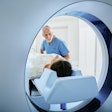
A new survey found that radiology staff members at a hospital in Dublin were reluctant to take simple actions that could save thousands of euros in energy costs -- such as shutting down PACS workstations when not in use. Administrators may therefore need to take more extreme actions, such as programming computers to automatically go into sleep mode overnight, to wring out cost savings.
A radiology department relies heavily on energy to run not only imaging devices such as CT and MR machines, but also interventional radiology suites and PACS. Add in the regular energy needed to run office equipment and lights, and you've got a costly enterprise -- both in terms of environmental impact and the department's bottom line, according to a new study published in Academic Radiology.
 Dr. Colin McCarthy from St. Vincent's University Hospital.
Dr. Colin McCarthy from St. Vincent's University Hospital.But this heavy energy use offers the opportunity for radiology to be a conservation leader, according to lead author Dr. Colin McCarthy, of St. Vincent's University Hospital in Dublin, and colleagues. Conservation efforts can be fairly simple, they noted: Just by turning computers off overnight, a department can save carbon dioxide emissions in a year equivalent to that of 10 passenger cars (Acad Radiol, 4 September 2014).
"By virtue of our reliance on technology, radiologists have the potential to lead the way in the field of energy saving in the healthcare setting," the authors wrote.
Power on
For the study, McCarthy's group assessed the power consumption in the radiology department of different devices that used power monitors over the course of a week. The team then calculated the yearly financial and environmental cost of leaving equipment on overnight and on weekends (which they had determined to be 6,396 hours). The team used kilowatt hours (kWh) to measure energy consumption and an average cost of commercial electrical energy of $0.10 (0.08 euros) per kWh -- the current U.S. figure when the study was conducted.
McCarthy and colleagues found that 29 of 43 desktop computers and 25 of 27 PACS reporting stations were left on unnecessarily overnight and/or on weekends, resulting in estimated electrical running costs of approximately $7,253 (5,692 euros) per year and greenhouse emissions of 51.2 metric tons of carbon dioxide. To make matters worse, none of the department's PACS reporting stations included energy-saving modes.
Presenting the study results to department staff didn't do much to change habits, McCarthy said. In fact, when the researchers conducted a follow-up audit 18 months later, they found there was actually an increase in the number of PACS workstations left on overnight.
"The amount of energy used by dozens of PACS reporting stations that were left on while not in use added up to thousands of dollars," McCarthy told AuntMinnieEurope.com via email. "And as a result of heat generated by the computers, air conditioning costs for the reporting rooms also ran in the thousands of dollars for the periods that the reporting rooms were not in active use. But, unfortunately, even after alerting people to the financial and environmental cost of leaving computers on overnight, staff members were reluctant to switch off their computers."
| Energy and financial savings in radiology by activity | ||
| Action | Energy saved per year | Money saved per year |
| Turn off desktop computers at night and on weekends | 25,040 kWh | $2,504 (2,035 euros) |
| Turn off PACS reporting stations at night and on weekends | 47,490 kWh | $4,749 (3,727 euros) |
| Turn off conference equipment at night and on weekends | 6,677 kWh | $667 (523 euros) |
| Turn off air-conditioning units in conference rooms at night and on weekends | 37,097 kWh | $3,709 (2,911 euros) |
| Total savings | 116,304 kWh | $11,629 (9,126 euros) |
If individual users are reluctant to change their habits, how can the simple conservation tactic of turning devices off overnight and on weekends be implemented? It might be better to focus on ensuring that the radiology department's machines have energy-conserving modes, and asking vendors to reduce the power consumption of CT and MR devices, as well as fluoroscopy suites, McCarthy and colleagues wrote.
"In order to achieve true energy savings, PACS workstations and other computers in the radiology department could be forced into 'hibernate' mode, or powered off altogether, at predefined times or following periods of inactivity," McCarthy told AuntMinnieEurope.com. "Of course, many facilities have backup and maintenance processes that run overnight, so these events would need to be incorporated into any automated power-saving schedule."



















